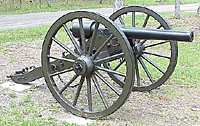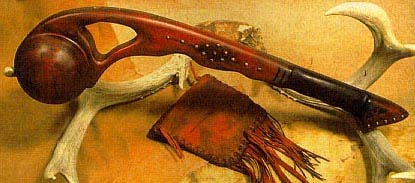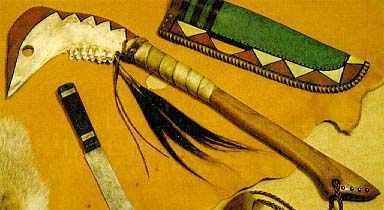
![]()
The Spencer Rifle

The Parrott Rifle

Indian Arrows

The Ball Headed Club

The Jawbone War Club
![]()
The Henry Rifle
8th American History
Rossville Jr. High
Plains History Project
2004
 |
|
| During the Indian Wars a variety of weapons were used. The United States Army and the Native Americans had some interesting weapons. The United States used everything from a Colt pistol to a Gatling gun. The U.S. had great fire power, but the Indians had something different. They had bows and arrows and many types of war clubs. They were skilled with their weapons and as deadly as if they were using guns. There was one weapon that both the United States and the Indians used. This weapon was the Henry was the Henry repeating rifle. This was a very amazing and very successful gun. Many weapons were used in the Indian Wars and they were all part of the history of it. | |
| The United States Army used many guns in the Indian Wars. In the 1870's they mostly used the repeating carbine Spencer, the Sharps carbine, and the Springfield single shot .50 caliber rifle. The infantry used the .45 Springfield in 1873 and the cavalry used the same caliber, but with a shorter carbine. The Springfield .45 and .50 cal. were single shot. The .45 was effective at 400 yards. With a velocity of 1200 fps, it will fly about 1000 yards. |
The Spencer Rifle |
| Since the Indians had more repeaters you would think they had the upper hand, but the U.S. was not an under-dog. The United States used the single shot for a reason. The had two very good reasons for staying with what they used. The first reason they chose single shots was because the soldier would waste ammo with repeaters and the Army just didn't have the money to do this. Reason number two was that they thought plain and simple that the Springfield was a better gun. At long ranges the Springfield .45 had great accuracy. The U.S. held accuracy higher than filling the sky with bullets for the type of fighting they did. | |
| The six shot .45 cal. Colt single action revolver was the pistol of choice in 1874. The U.S. used Gatling guns. They were .50 cal. and fired 300 rounds per minute. The Gatling gun had never been used west of the Mississippi River in combat until the Red River War. A 10-pounder Parrott rifle was used, which wasn't a rifle at all but a small cannon. With a range of 2000 yards, a shell nearly 9 inches long, and 3 inches in diameter this was a powerful weapon. A short barreled mountain howitzer was also used. |
The Parrott Rifle |
| Indians used their battle proven weapons in the Indian Wars. Bows and arrows were greatly feared since the arrows were so deadly. It took very skilled surgeons to remove the arrowheads from the soldiers. The East was the first place soldiers had to deal with the Indians arrows and what their arrows could do. Eastern Indians quick got a hold of guns, though. The weapon of choice for the Western Indians were bows and arrows because the guns were hard to find and the ammunition was just as hard to come by. | |
| Indians believed that arrows were sacred gifts from the Creator. There were many myths about arrows. Geronimo told a Chirichua Apache myth about an eagle sharing his bow and arrows with Apaches and teaching them how to use it. In one Cheyenne creation myth, Mahoe, the creator, gives Sweet Medicine Four medicine arrows called Mahuts. The were guarded by the Arrow Keepers in a special tepee because there would be no Cheyenne tribe without the Mahuts. Since arrows represented the Creator, healers that used arrows in their healing rituals were powerful. Medicine men that could heal arrow wounds were called "arrow shaman" in the Chemehuevi way. Pima healers shot arrows at "evil spirits" to cure the wounded. Yumas and Modocs did things like this also. | |
| Bows and arrows were great weapons. Arrows could accurately be shot at 100 yards. Comanches had guns from the middle 1700s onward, but used bows and arrows also because they were good for ambushes. Author Richard Perry wrote in 1868 that " The bow and arrow in the hands of skillful warriors proves very deadly...best weapon that can be used in the chase...can be worn without the slightest sense of encumbrance...they can always be relied on..." You would always have the resources to make bows and arrows. Arrowheads could be made out of anything sharp and everything else was made out of wood. Some Indians dipped arrows tips in poison, but it was useless since the arrows were already deadly. Half of the Indian warrior used bows and arrows in the Battle of the little Bighorn. Their tactic was to shoot indirectly and the enemy wouldn't know where they were. |
Indian Arrows |
| Dr. J.H. Bill wrote about arrow wounds and he said that these wounds heal fast in the desert. He also told soldiers, "The upper extremity is often most wounded, next comes the abdomen, next the chest, and next the lower extremity." Arrowheads often came off the shaft when soldiers tried to pull the arrow out. Blood is what made it come loose. The muscles would contract and it would be hard for the doctors to get it out. | |
| Although arrows were deadly, some people did live to see another day. An unknown person was hit with a Comanche arrow. A verbal report said," The weapon pierced the upper part of the right point protruding at the back between the scapula and the spine. A silk handkerchief was fastened to the shaft, which was pushed through his body..." He healed and was on active duty for many more years. Private John Krumholz was hit with an an arrow in his left eye. The arrow was about two inches into his head. It was removed and four days later he returned to active duty. Bows and arrows didn't rule the West, but they were a big part. Arrows were deadly, still the soldiers had a chance to live. | |
| Bows and arrows weren't the only weapons the Indians used. Indians used hand weapons, too. Indians made knives from sharp pieces of bone. Traders traded Indians steel knives. All Indians wanted wanted "trade" knives. A lot of Indians got their steel knives from fur traders. They used their knives for everything. They used them for scalping, cleaning animal, and anything you can think of. Tomahawks came around in the early 1600s. It weighed about one pound. Indians made them, but Europe also mass-produced tomahawks. They had a spike on the back or a pipe to smoke. Indians used many war clubs. The jawbone war club was mostly used in the plains. They used pieces of animal jawbone to make them. They were used on horseback. The gunstock war club was used in the Woodland and Plains regions. It wasn't a real gun stock, it was just the shape of one. It was a symbol of power. It had a blade sticking out on one side. The ball headed club was used in the Woodland area. It was made out of one piece of hardwood. The ball at the end was 3 to 5 inches. The first club appeared in the early 1600s. |
The Ball Headed Club
The Jawbone War Club |
| Although the United States Army and the Indians had very different weapons, they both used one. This one weapon was the Henry repeating rifle. The Rebels called the .44 cal. Henry "that damned Yankee rifle that can be loaded on Sunday and fired all week." In 1854 the lever-action Volcanic rifle was introduced. The lever-action was a good idea, but the gun was a failure. The ammunition was not consistent. The projectile was lead. A cavity in the lead is where the powder was. A perforated cork disc seated the powder. The ammo was the cause of it failure. | |
| B. Tyler Henry of the New Haven Arms Company used the same idea, but used a rimfire bullet. It held sixteen rounds. It was designed in 1857 and patented in October 1860. The Henry was popular, but the government only bought 1731 of them and mostly bought by soldiers that were discharged but couldn't part with their guns. In 1865 the Civil War was over and Spencer's became cheap, but people preferred the Henry even if it cost seventy-five dollars. The Henry helped many people survive in the Plains. George Ray of a train of 25 wagons went hunting. Indians surround him. He fought the band off with his Henry and made it back to his train. |
The Henry Rifle |
| In June 1865, Albert J. Fountain and Corporal Val Sanchez were on the trail of some raiding Navahos in New Mexico near the Rio Grande. The Indians turned and came after them. Fountain and Sanchez headed into a mountain pass that went to Fort McRae. They thought they lost the Indians but were afraid of an ambush. Fountain told Sanchez to go a different way. Then his horse was killed when it was hit with a bullet. Fountain was stuck under his horse. He was shot with an arrow in his left shoulder and right forearm. A bullet hit him in his left thigh. With his Henry he killed ten Indians and scared the others away. Help came the next day. | |
| Luther S. "Yellowstone" Kelly bought the .44 cal. Henry carbine for fifty dollars in 1868. He said "With the Henry and the stubby little .44 caliber cartridges that went with it. "I killed many a buffalo, as well as other game, defend myself in encounters with hostile Indians." Kelly was to carry mail between Fort Berthold and Fort Stevenson. On one trip, two Sioux came upon him. One with a shotgun and one with a bow. They started shooting from thirty yards. Kelly popped the one with a shotgun quick. The other hid behind a tree, but Kelly got him in the arm. The Indian charged with an arrow like a knife to stab. Kelly dropped him dead. | |
| The Indians liked Henrys, too. Some friendly looking Sioux entered the camp of some young wood yard workers in 1868 and asked to look at their Henry. The Indians killed the owners with their own guns. Many post traders were selling Henrys and ammo to Indians as early as 1869. The government tried to stop them, but couldn't. The .44 cal. bullet was not made to be made to be reloaded. The Indians did and we know this because they still used rim fire after center fire came out. The Indians used the Henry for 20 years. It was last used in the mid-1880s. Many weapons were used in the war between the United States and the Native Indians and they all were a big part of it. | |
|
Neil Loehr
8th American History Rossville Jr. High Plains History Project 2004 |
Bibliography |
Revised: February 05, 2004 |
|